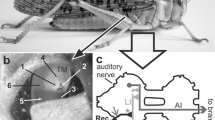Summary
-
1.
The temperature sensitivity of thermoreceptors and slowly adapting mechanoreceptors in the trigeminal area of pigeons were tested while recording from all three main branches of the trigeminal nerve.
-
2.
Warm receptors were excited by warming and totally inhibited by cooling. During rewarming no overshooting excitation occurred. The impulse frequency increased with increasing temperature; at low temperature the receptors fired in bursts.
-
3.
A special “warm-sensitive” receptor with a regular discharge rate at high skin temperature was totally inhibited by cooling and restored its initial frequency after rewarming without any overshoot. The impulse frequency did not increase with increasing temperature but was constant above a critical skin temperature.
-
4.
Most of the slowly adapting mechanoreceptors had a very regular, rather high impulse frequency (20–50 imp./sec) at constant mechanical stimulus. The impulse frequency decreased during cooling without an excitatory overshoot and increased during warming without an inhibition.
-
5.
Only few slowly adapting mechanoreceptors were excited by cooling and inhibited by warming, a behaviour which is reported for all temperature-sensitive mammalian mechanoreceptors.
Similar content being viewed by others
References
Botezat, E.: Die Nervenendapparate in den Mundteilen der Vögel und die einheitliche Endigungsweise der peripheren Nerven bei den Wirbeltieren. Z. wiss. Zool.84, 205–360 (1906).
Burton, H., Terashima, S.-I., Clark, J.: Response properties of slowly adapting mechanoreceptors to temperature stimulation in cats. Brain Res.45, 401–416 (1972).
Chambers, M. R., Andres, K. H., Düring, M. v., Iggo, A.: The structure and function of the slowly adapting type II mechanoreceptor in hairy skin. Quart. J. exp. Physiol.57, 417–445 (1972).
Chambers, M. R., Iggo, A.: Slowly-adapting cutaneous mechanoreceptors. J. Physiol. (Lond.)192, 26–27 (1967).
Duclaux, R., Kenshalo, D. R.: The temperature sensitivity of the type I slowly adapting mechanoreceptors in cats and monkeys. J. Physiol. (Lond.)224, 647–664 (1972).
Gregory, J. E.: An electrophysiological investigation of the receptor apparatus of the duck's bill. J. Physiol. (Lond.)229, 157–164 (1973).
Hensel, H.: Classes of receptor units predominantly related to thermal stimuli. Ciba Foundation Symp. Touch, Heat and Pain (ed. De Beuck, A. V. S., and J. Knight). London: J. & A. Churchill Ltd. 1966.
Hensel, H., Zotterman, Y.: The response of mechanoreceptors to thermal stimulation. J. Physiol. (Lond.)115, 16–24 (1951).
Hunt, C. C., McIntyre, A. K.: Properties of cutaneous touch receptors in cat. J. Physiol. (Lond.)153, 88–98 (1960).
Iggo, A.: Cutaneous thermoreceptors in primates and subprimates. J. Physiol. (Lond.)200, 403–430 (1969).
Iggo, A., Muir, A. R.: The structure and function of a slowly adapting touch corpuscle in hairy skin. J. Physiol. (Lond.)200, 763–796 (1969).
Kenshalo, D. R., Gallegos, E. S.: Multiple temperature-sensitive spots innervated by single nerve fibres. Science158, 1064–1065 (1967).
Kitchell, R. L., Ström, L., Zotterman, Y.: Electrophysiological studies of thermal and taste reception in chickens and pigeons. Acta physiol. scand.46, 133–151 (1959).
Necker, B.: Response of trigeminal ganglion neurons to thermal stimulation of the beak in pigeons. J. comp. Physiol.78, 307–314 (1972).
Poulos, D. A., Lende, R. A.: Response of trigeminal ganglion neurons to thermal stimulation of oral-facial regions. I. Steady-state response. J. Neurophysiol.33, 508–517 (1970).
Poulos, D. A., Lende, R. A.: Response of trigeminal ganglion neurons to thermal stimulation of oral-facial regions. II. Temperature change response. J. Neurophysiol.33, 518–526 (1970)
Rautenberg, W.: The influence of the skin temperature on the thermoregulatory system of pigeons. J. Physiol. (Paris)63, 396–398 (1971)
Witt, I., Hensel, H.: Afferente Impulse aus der Bxtremitätenhaut der Katze bei thermischer und mechanischer Reizung. Pflügers Arch. ges. Physiol.268, 582–596 (1959)
Zeigler, Ph., Witkovsky, P.: The main sensory trigeminal nucleus in the pigeon: a single-unit analysis. J. comp. Neurol.134, 255–263 (1968)
Author information
Authors and Affiliations
Additional information
Supported by the Deutsche Forschungsgemeinschaft (Ra 167 and SFB 114, Bionach).
Rights and permissions
About this article
Cite this article
Necker, R. Temperature sensitivity of thermoreceptors and mechanoreceptors on the beak of pigeons. J. Comp. Physiol. 87, 379–391 (1973). https://doi.org/10.1007/BF00695271
Received:
Issue Date:
DOI: https://doi.org/10.1007/BF00695271




